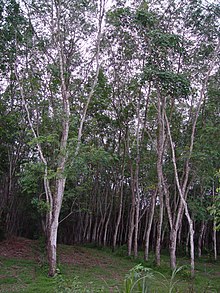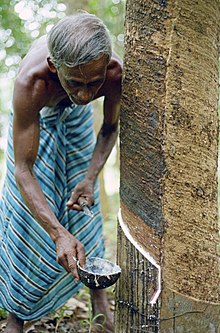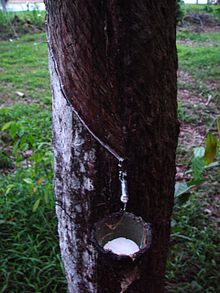Rubber tree
| Rubber tree | ||||||||||||
|---|---|---|---|---|---|---|---|---|---|---|---|---|

Rubber tree ( Hevea brasiliensis ), |
||||||||||||
| Systematics | ||||||||||||
|
||||||||||||
| Scientific name | ||||||||||||
| Hevea brasiliensis | ||||||||||||
| ( Willd. Ex A.Juss. ) Müll.Arg. |

The rubber tree or Para rubber tree ( Hevea brasiliensis , Syn. : Siphonia brasiliensis . A. Juss ) is one of South America native plant species from the family of the spurge family (Euphorbiaceae).
The term rubber tree , which is also used for the unrelated species Ficus elastica , is also common.
The tree is of great economic importance because its natural rubber (rubber) or its milk sap, known as natural latex (latex), is the most important natural source of this renewable raw material for rubber production . Today, however, a large part of the demand is met by synthetic rubber produced by petrochemicals . The polyisoprenes (polyterpenes) of this natural rubber are, like those in the guayule ( Parthenium argentatum ), cis -configured, in contrast to the rubbery parts of the gutta-percha and the balata or the mixed-configured chicles .
Due to this intensive use, the rubber tree became widespread and is mainly grown in plantations in Asia and other areas of the so-called rubber belt.
description
Vegetative characteristics
Hevea brasiliensis is a deciduous tree that reaches heights of growth of around 20 to 40 m and, in plantations, trunk diameters of around 35 cm. The core and sapwood are yellowish and have an unpleasant smell when fresh. The relatively smooth to slightly scaly bark is brownish to light gray. Milk tubes (milk juice vessels) through which the milk juice flows run in the soft bast of the trunk . This consists of 55–70% water and 30–40% rubber. The remaining substances are sugar , proteins , resins and waxes , which each only make up 0.5–2%. The branching is even and the branches are more or less upright. The bark of the branches is smooth.
The spirally arranged, long-stalked and papery leaves are threefold. The leaf stalk is up to about 10-20 centimeters long. The middle leaflet is often larger than the two on the side. The elliptical to obovate, lanceolate, shiny and short-stalked leaflets are dark green on top and pale green on the underside. They have a distinctive, light green and parallel-forward feathered vein . They are about 7–20 cm (up to 25 cm) long and 3–8 cm (up to 10 cm) wide. The leaflet margins are whole, the tip is pointed to pointed. There may be 2–3 glands (extra-floral nectaries) on the base of the leaf or on the stem.
The sometimes angular petioles are usually 6–20 cm (rarely up to 30 cm) long. The rubber tree forms its leaves anew every year. The stipules are lanceolate and about 1 mm long. The stipules fall off early.
Generative characteristics
Directly under the accumulation of leaves at the end of the branches, a pseudo-terminal, up to 25 cm long, mixed and stalked panicle inflorescence with about 0.5 mm long bracts is formed. Hevea brasiliensis is monoecious mixed-sex ( monoecious ). The pungent, penetrating smelling, stalked and yellow, bell-shaped flowers have a simple flower cover and without petals.
The male flowers have a 5-6 mm long, five to six-lobed, pointed and hairy calyx and two circles with five stamens each , which have grown together to form a 1.5 mm high column (androphor) around the fine-haired pistil (sterile pistil), the anthers are arranged in two horizontal rows one above the other. The terminally arranged, few female flowers have a somewhat wider and longer, similar calyx to the male. The upper, fine-haired and three-chambered ovary is almost spherical and below often surrounded by the small floral nectaries ( discus ), the three sessile stigmas are 0.2-0.3 mm long.
The woody, stalked capsule fruit , brownish when ripe , with three to four ellipsoidal capsules, is about 4 to 5 cm in size. When they are ripe, the capsules explode ventrally (on the abdomen) with a very audible bang and eject their seeds over great distances. The hard, shiny, egg-shaped to ellipsoidal and large seeds are up to about 2.3 × 1.5 cm in size, light brown to grayish with dark brown spots, stripes or speckles. The seeds are about 2–6 g in weight, the thousand-grain mass is approximately 3600–4250 g. The seeds are poisonous, they contain cyanide , the tegmen is paper.
The number of chromosomes is 2n = 36.
History and dissemination
origin
Originally the occurrence was limited to the tropical Amazon basin . The indigenous population also called the plant "ca-hu-chu", which means something like "weeping wood". In the 15th century , the Portuguese were the first to report about latex and recognized its positive properties, such as the possibility of making waterproof clothing by coating it with the viscous juice, similar to tapa bark fiber from Polynesia . After the discovery of the manufacturing process of rubber (by vulcanization of rubber) in 1839, the demand increased enormously and led to a rubber boom in the Amazon region around Manaus and Belém .
Spread through the rubber boom
Brazil held the world monopoly for decades, even after natural rubber was extracted in the African tropics. After several failed attempts by others succeeded in 1876 the adventurer Henry Wickham on behalf of the British India Office and the Royal Botanic Gardens, Kew ( Royal Botanic Gardens, Kew ) in London to bring rubber tree seeds out of the country. In the East Asian areas of the Straits Settlements (Malay Peninsula), after various setbacks in the 1890s , the first plantations were built, which brought their products to the world market from 1905 . Soon repressed British rubber from Malaya Brazilian from the world market, and the UK exercised a monopoly over the global rubber trade.
Today's distribution
Today the tree is mainly planted in the so-called rubber belt (around 30 ° north to 30 ° south ). The three largest producing countries are Thailand , Indonesia and Malaysia . The Brazilian stocks, on the other hand, are currently severely threatened by the South American leaf fall disease , which is triggered by the parasitic fungus Microcyclus ulei . In addition to mismanagement, this fungus is also held responsible for the decline of the Fordlândia rubber plantation established in Brazil at the beginning of the 20th century by Henry Ford , owner of the Ford concern . The fungus mainly infects the rubber tree during the roughly two-week phase in which a new leaf is developing. In the humid equatorial climate, new leaves develop all year round, making the tree very susceptible to infections . In contrast, in regions characterized by the seasons , the fungus has fewer opportunities for an infestation. This is e.g. This is the case, for example, in the state of São Paulo, which is characterized by cooler and drier winters , so that today around 60% of Brazilian rubber is produced there.
A large part of global rubber demand (forecast: 23.9 million t in 2009) is now covered by synthetic rubber (forecast: 13.5 million t in 2009). Nevertheless, an increase in demand for natural rubber is expected in the future (forecast: 10.4 million t in 2009). In 2019, rubber demand of 30.4 million t is expected, of which natural rubber is expected to make up 14.0 million t. Therefore, a significant expansion in cultivation areas can be expected.
use
harvest
After about five to six years, the crop is old enough to produce the milk sap , which is also known as natural rubber or latex in the rubber tree . The milk tubes run counterclockwise at an angle of 3.5 ° to the vertical direction. Therefore, the tenon cut is made spirally with a special knife from top left to bottom right at an angle of 30 ° to the horizontal direction. When cutting, the cambium located under the milk tubes must not be destroyed under any circumstances, as otherwise no regeneration of the bark and thus the milk tubes is possible. The milky juice comes out and is collected in small buckets. The cut is only made over half of the tree's circumference, so that a living strip ensures the water and nutrient supply.
| Composition of latex (milk juice from Hevea brasiliensis) |
|---|
| 60-75% water |
| 25-35% rubber |
| 1.5-2.5% resins |
| 1.5–2% protein |
| 0.5–1% minerals |
Reuse

At around 25 years of age, the tree stops producing latex, so that it is felled in the plantation economy and replaced by new plants. The resulting wood, so-called "rubberwood", approx. 50 million m 3 per year, is trendy with its light, warm color and becomes clear thanks to its high hardness, approx. 6.2 according to the Brinell hardness test harder than beech , for example , approx. 4.1; Maple approx. 4.7 or oak approx. 4.3; and its insensitivity to fluctuations in humidity is also used more and more for furniture construction. The plants grown in monoculture make up a large part of furniture wood in some countries, such as Malaysia . In Europe, too, it is increasingly used for interior work. The wood is also processed into toys and is also used in musical instrument making.
literature
- A. Radcliffe-Smith: Euphorbiaceae in Flora Zambesiaca , Volume 9, Part 4, 1996. online. (engl.).
- PC van Welzen, H. van Sam: Revision of Annesijoa, Elateriospermum and the Introduced Species of Hevea in Malesia (Euphorbiaceae). In: Blumea. 49 (2-3), 2004, pp. 425-440, doi: 10.3767 / 000651904X484351 , online at researchgate.net and online at Nationaal Herbarium Nederland, accessed on January 23, 2018.
Web links
- Lexicon Renewable Resources Michael Pankratius.
- HG Richter & MJ Dallwitz: Commercial Timber : DELTA: Department of Biology at the University of Hamburg: Information on the use of wood .
- Internet presence of the International Rubber Study Group (IRSG) , establishment of the global rubber industry for the provision of statistical data in the field of rubber, only partially freely accessible.
- Technical information from German transport insurers: Comprehensive description of the extraction and processing of natural rubber .
- Hevea brasiliensis from Useful Tropical Plants, accessed January 20, 2018.
Individual evidence
- ↑ a b Useful plants and other interesting things in botany ( Memento of the original from June 14, 2008 in the Internet Archive ) Info: The archive link has been inserted automatically and has not yet been checked. Please check the original and archive link according to the instructions and then remove this notice. , Internet project of the University of Marburg, Department of Special Botany, 2003/04, accessed on March 2, 2010.
- ^ A b P.M. Priyadarshan: Biology of Hevea Rubber. Springer, 2017, ISBN 978-3-319-54504-2 , pp. 21–33.
- ↑ a b c Royal Botanic Gardens, Kew: Botanical description of the rubber tree (Hevea brasiliensis (A. Juss.) Müll. Arg.) , Accessed on February 25, 2010.
- ↑ MC Dornelas, AP Rodriguez: The rubber tree (Hevea brasiliensis Muell. Arg.) Homologue of the Leafy / Floricaula gene is preferentially expressed in both male and female floral meristems. In: Journal of Experimental Botany. Volume 56, Issue 417, 2005, pp. 1965–1974, doi : 10.1093 / jxb / eri194 .
- ^ PC van Welzen, H. van Sam:
- ↑ Willy H. Verheye: Soils, Plant Growth and Crop Production. Volume II, EOLSS, 2010, ISBN 978-1-84826-818-0 , p. 299.
- ^ Seed Information Database at Kew Royal Botanical Gardens, accessed January 20, 2018.
- ↑ Hevea brasiliensis at Tropicos.org. In: IPCN Chromosome Reports . Missouri Botanical Garden, St. Louis
- ↑ a b Hans-Dieter Feger: History and economic development of rubber ( Memento of the original from March 18, 2014 in the Internet Archive ) Info: The archive link was automatically inserted and not yet checked. Please check the original and archive link according to the instructions and then remove this notice. , Summary of a diploma thesis including various illustrations, Innsbruck, 1973, accessed on April 1, 2017.
- ↑ a b c SwissEduc : Pictures on the raw material rubber , pictures and information on natural rubber, accessed on February 25, 2010.
- ↑ a b B. Epping: Brazil is fighting for its rubber In: Bild der Wissenschaft . 12, 2007, pp. 30-34.
- ↑ International Rubber Study Group (IRSG): Recent News ( Memento of the original from February 23, 2010 in the Internet Archive ) Info: The archive link was inserted automatically and has not yet been checked. Please check the original and archive link according to the instructions and then remove this notice. , updated on December 22, 2009, accessed on February 25, 2010.
- ↑ Gunther Franke: Useful plants of the tropics and subtropics .
- ↑ Rubber wood on holzhandel.de, comprehensive information on the origin and properties of rubber wood on the website of the Gesamtverband Deutscher Holzhandel e. V., accessed February 25, 2010.




